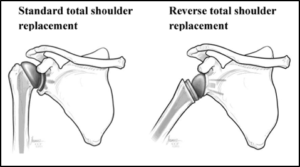Traditional shoulder replacement surgery isn’t always the right treatment for shoulder pain. Patients with large tears in their rotator cuffs or cuff tear arthropathy (wear and tear arthritis) can still end up in pain and with limited mobility.
Fortunately, there is another option. Reverse shoulder replacement surgery was created specifically to help these types of patients find relief from pain.
What is Reverse Shoulder Replacement Surgery?

With a standard shoulder replacement, the damaged humeral head is replaced with a metal ball and a plastic cup is placed in the shoulder socket.
Reverse shoulder replacement surgery is just the opposite; the metal ball is inserted into the socket and a plastic cup is attached to the upper end of the humerus.
Candidates for Reverse Shoulder Replacement Surgery
Standard total shoulder replacements are successful for patients with painful arthritis. But patients with other conditions may still have pain and limited mobility with a traditional replacement. Reverse total shoulder replacement is a better option for those with:
- Fully torn rotator cuffs that can’t be repaired

- Complex fractures in the shoulder joint
- Chronic shoulder dislocation
- Shoulder joint tumor
- Rotator cuff tear arthropathy (wear and tear arthritis)
- Previously unsuccessful traditional shoulder surgeries
A conventional shoulder replacement uses the rotator cuff muscles to function properly. For patients with damaged rotator cuffs, a reverse shoulder replacement relies on a different muscle (the deltoid) to move the arm. This helps patients find much-needed pain relief.
